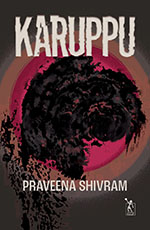How do you review a book like Karuppu? I’ve asked myself this question ever since I finished reading it. Last page read, book shut…and there I am, left with a feeling that I have yet to emerge from a fog-shrouded mystical world, sprinkled with violence, poignancy, tragedy, micro-stories of relationships filled with sharp shards, and a sense of something ending. Alongside are clearly etched images, sentences that spring out at you—and the very compelling presence of the author’s powerful imagination.
This is a story which takes place in a rather special ‘Underworld’, filled with ‘spirals’—dwelling places for Yama, the Lord of the Underworld, and his Yamadootas. Yama’s spiral expels upon exhalation ‘the dense clutter of death energy’ into the River Vaitarni, which surrounds this world.
It has been two days since Yama disappeared, along with his diary, the Yamagata. At the most recently held Council of the Gods, which happens once every century, Brahma reveals that Earth has reached the ‘end of its capacity’ and that Gods can no longer ‘apply’ to ‘enter Earth as mortals’. Incidentally, Earth was just ‘Project Earth’…which was begun mainly to ‘give immortal Gods a chance to experience mortality’. Earth is where you forget your divine roots.
And now, Yama, forced to confront the decaying of his precious world, disappears with the book.
Yama’s lineage is impressive—his father Vivaswat powered the Sun, and Grandfather Vishwakarma is the divine architect and ‘chief consultant for Project Earth’. Yama was just 14 when he was sent to Earth, only to die of snake bite because ‘the Gods still hadn’t completely figured out this mortality business’. All mythical beings here are essentially flawed and vulnerable, riddled with existential doubts and angst. Clearly, this is a world which is still a work in progress.
The book tells two interwoven stories, with the chapters alternating between Sigappi and Karuthamma. Karuthamma is the child of the only female Yamadoota, Karuppu, who is Yama’s twin sister Yami’s daughter, and appears to be at the storm centre of all the chaos unleashed now. Karuppu’s adopted son, Sigappan, taken to the underworld as an infant, grows up with the Yamadootas. The story speaks of the relationship between Yama and Yami, who was ‘the reason for Yama’s being’.Yami, an immortal on Earth, is trying to maintain order in the face of her brother’s disappearance.
So much seems to exist in the in-between in this book—fluidity between realms, between Earth and the Underworld, between different spirals, the living and the not-completely-dead. Even gender can be fluid–as expressed in the character of Sigappan.
The afterlife is as confused and layered as life on Earth. This is a place where you learn to ‘navigate dreams, jump dimensions, and generally begin to work with your mind, rather than your body’. So, as Karuthamma discovers, it is not a place of monsters, dead souls waiting to feast on human hearts, with Yama riding around on his buffalo wielding his dreaded noose. The mere thought of food ensures a meal arrives before you, fully cooked. The air simply cleanses itself every day, so everyone is always fresh. At the end of mortal life, the soul travels to the Underworld, and then on to ‘Kanavu’. Dreams and memories are living entities, conjoined wheels, with memory being smaller.
Aimed at Young Adults, the language is easy, accessible–protagonist Sigappi uses the pronoun ‘you’, breaking down the fourth wall and bringing the reader into this rather torturous journey, navigating the chaos Yama has created.
But at times you find yourself wondering, ‘What exactly is going on?’ and wish there was more clarity, even explanations provided by back-stories, the whys and the hows behind each step in the story’s progress. This creates a sense of something incomplete, with a constant promise of revelations and explanations that are never fulfilled.
For instance, nearly seventy pages into the book, you wish someone would explain why ‘spirals’, and exactly how they work. Finally, a few pages later, you get a hint. The Yamadootas are all fascinating in their own right–you sense intriguing backgrounds hovering behind each of them, but their stories stay tantalizingly hidden.
There are some truly arresting sentences–a description of someone’s death throes: ‘his breath coming like wisps of smoke from an agarbatti’.Or this one: ‘the grains of sand falling through my fingers like broken promises’. And this tragic summing up of a human life experience: ‘You see the truth of your life only when you are not in it.’
You also like the fact that non-English takes its place comfortably alongside English–it is ‘balappam’, not ‘chalk’, and even better, no self-conscious italics. And comfort food is not chicken soup but ‘warm rasam rice’, balm to many South Indian hearts.
When you finally emerge from that aforementioned fog, a thought remains–that there is a lot more to these characters. If delved into again, there’s a whole world here waiting for more stories to be told.
November 2023, volume 47, No 11

